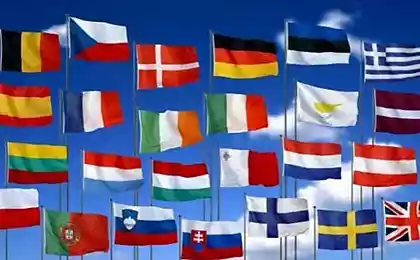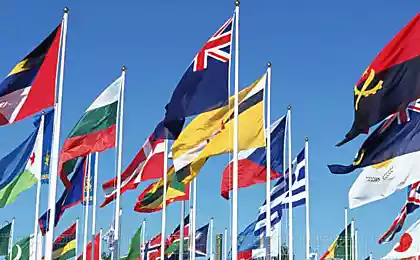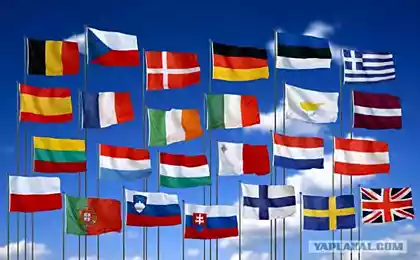6500
Interestnye facts about various flags
We offer you a selection of interesting facts about different flags.
1. The oldest flag in the world
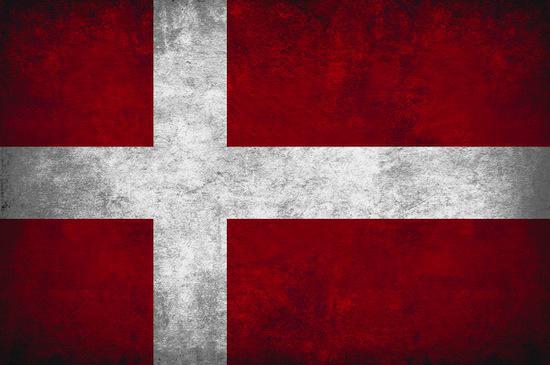
Flags first appeared in China and India, and later spread around the world. Because that flags any so long it is impossible to identify which was the first flag. However, it is proved that the Dannebrog - the oldest flag of the world, which is still used today.
Going back far into the 13th century, presumably from June 15, 1219, the Dannebrog is the national flag of Denmark, and serves as the inspiration for the design of the flag of other Scandinavian countries. Until its formal adoption flag was used mainly in the region of the Vikings and had a triangular edges. Austria also claims to be the oldest possession of origin flag in the world, although their flag, apparently dates from the 1230th year.
2. The flag semaphore

Language - is not just speech and movement. Flags, semaphores - a system for transmitting information from a distance with the help of visual signals by hand flags, rods, disks, and sometimes with bare hands or gloved hands. Information is encoded by the position of the flag and read when the flag is in a fixed position.
Semaphores were adopted and widely used in the marine world since the early 1800s (hand flags replaced by the so-called "mechanical hands"). Semaphore signals, for example, were used in the Battle of Trafalgar. This was the period when invented the modern system of naval semaphore flags which used manual. It is still used for emergency communications during the daytime, but at night instead of flags used lighted sticks.
3. The non-rectangular flag

The flag of Nepal is the only flag in the world appear rectangular. The flag is a simplified combination of two separate pendants. His crimson color - the color of the rhododendron, the national flower of the country. Red is also a sign of victory in war, blue frame - the color of peace. Until 1962, the emblem of the flag (the sun and crescent) had human faces.
In order to modernize the flag person decided to remove. Persons remained in the Royal Standard until the abolition of the monarchy in 2008. The flag was adopted with the formation of a new constitutional government December 16, 1962-year. Individual pennants used in the preceding two centuries, the same double pennant began to be used from the 19th century.
4. White Flag
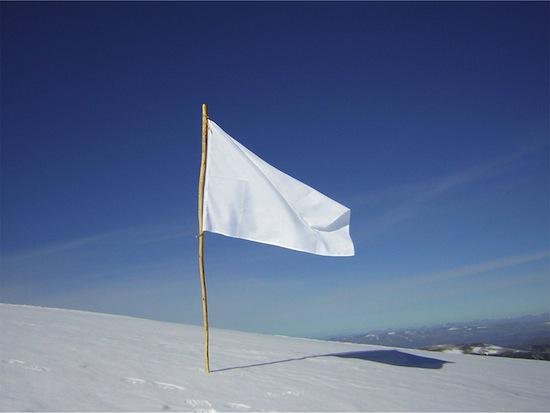
White flag - is internationally recognized protective sign of truce or ceasefire, and request for negotiation. It is also used to signal surrender, so often the weaker military party acts with this flag with the request for negotiations.
White flag indicates that the approaching negotiator is unarmed, in his intent either to surrender or a desire to start a dialogue. Persons who are holding a white flag, can not open fire on them and can not shoot. Use of the flag is included in the Geneva Convention.
5. Black Flag
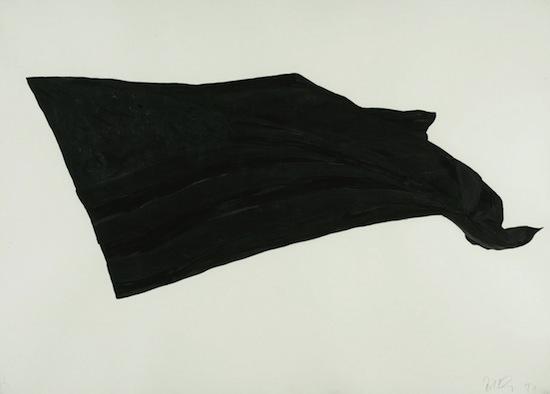
Black flag and black color as such have been associated with anarchy since the 1880s. The names of many anarchist groups contain the word "black". There were a number of emerging periodically anarchist organizations under the name "Black Flag».
Uniform black flag is the negation of all oppressive structures, in contrast to the colorful flags typical of most nation-states. In addition, if the white flag is the universal symbol of surrender to superior force, the black flag - a symbol of defiance.
6. Trans-flag
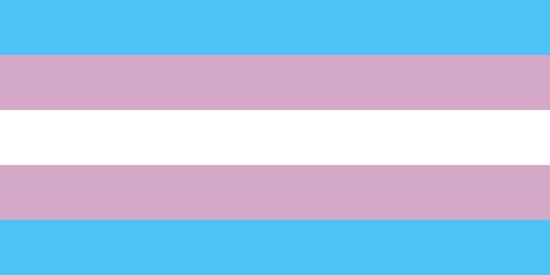
We are all familiar with the rainbow flag of the gay movement, however, is less well known in social circles transgender flag. It was created in 2000, when the first parade of the minority in the US city of Phoenix (Arizona).
The designer of the flag is very clearly explained why it is such a flag "Blue - a traditionally male, pink - female, white, located in the middle, symbolizing those in between who feels that has a neutral floor. The bottom line is that - no matter which way you choose, it will always be correct. This suggests our attempts to find justice in their own lives ».
7. Flag Jolly Roger

Jolly Roger - is the name given to any flag to identify the crew of a pirate ship. Today most recognizable Jolly Roger - a human skull, located above two crossed long bones. The whole composition is shown on a black background. This design of the flag was used by many famous pirates.
Some Jolly Roger flags depicted hourglass that in the 17-18 centuries in Europe were a symbol of death.
8. The flag of West Africa
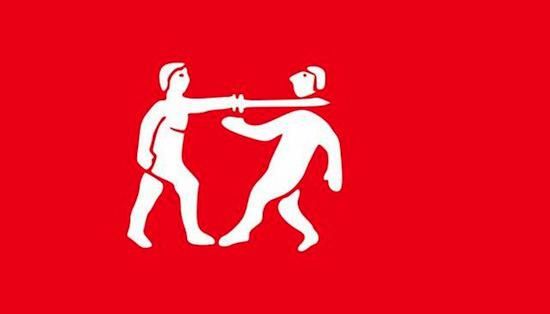
This unusual flag, as a rule, is often (erroneously) referred to as the Empire of Benin. This is one of the four flags, which is currently at the National Maritime Museum Greenwich, near London. There is some uncertainty as to the exact origin of the flag, whether it came directly from Benin or used neighboring nations.
The name "Kennedy", written on a paper label attached to the flag and, apparently, says that he was brought back to Admiral F. Kennedy in 1897, the year after the expedition against Benin, which may indicate that the flag has Benin origin. However, the flag is very similar to three other West African flag stored in the museum, which did not occur in Benin and from neighboring peoples.
9. Flag of Mars

Flag of Mars - a flag, representing the planet. Although it has no legal force, the flag was approved by the Mars community and planetary community. The flag is intended to represent the "future history" of Mars.
Red stripe, which is located closest to the mast, symbolizes Mars today. Green and blue are talking about the possible stages of terraforming Mars, that someday humanity will be able to perform this task, however, the ethics of terraforming the planet is still a matter of debate.
10. The Nazi flag
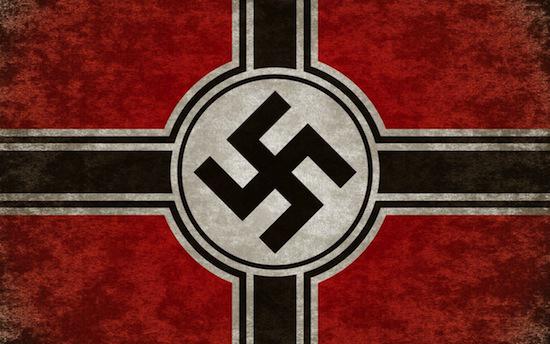
Nazi flag is probably the most controversial in the history of the flag of humanity. He even today banned in several countries. The flag was designed by Hitler himself, who believed that it was necessary to use the colors of Imperial Germany, because in his opinion, "the use of these colors - this is our tribute and respect for the glorious past that has brought so much honor to the German nation».
"The most important requirement for a new flag - he has to prove its effectiveness, because there are hundreds of thousands of cases, when really standing emblem may be the root cause of the awakening of interest in the movement."
1. The oldest flag in the world

Flags first appeared in China and India, and later spread around the world. Because that flags any so long it is impossible to identify which was the first flag. However, it is proved that the Dannebrog - the oldest flag of the world, which is still used today.
Going back far into the 13th century, presumably from June 15, 1219, the Dannebrog is the national flag of Denmark, and serves as the inspiration for the design of the flag of other Scandinavian countries. Until its formal adoption flag was used mainly in the region of the Vikings and had a triangular edges. Austria also claims to be the oldest possession of origin flag in the world, although their flag, apparently dates from the 1230th year.
2. The flag semaphore

Language - is not just speech and movement. Flags, semaphores - a system for transmitting information from a distance with the help of visual signals by hand flags, rods, disks, and sometimes with bare hands or gloved hands. Information is encoded by the position of the flag and read when the flag is in a fixed position.
Semaphores were adopted and widely used in the marine world since the early 1800s (hand flags replaced by the so-called "mechanical hands"). Semaphore signals, for example, were used in the Battle of Trafalgar. This was the period when invented the modern system of naval semaphore flags which used manual. It is still used for emergency communications during the daytime, but at night instead of flags used lighted sticks.
3. The non-rectangular flag

The flag of Nepal is the only flag in the world appear rectangular. The flag is a simplified combination of two separate pendants. His crimson color - the color of the rhododendron, the national flower of the country. Red is also a sign of victory in war, blue frame - the color of peace. Until 1962, the emblem of the flag (the sun and crescent) had human faces.
In order to modernize the flag person decided to remove. Persons remained in the Royal Standard until the abolition of the monarchy in 2008. The flag was adopted with the formation of a new constitutional government December 16, 1962-year. Individual pennants used in the preceding two centuries, the same double pennant began to be used from the 19th century.
4. White Flag

White flag - is internationally recognized protective sign of truce or ceasefire, and request for negotiation. It is also used to signal surrender, so often the weaker military party acts with this flag with the request for negotiations.
White flag indicates that the approaching negotiator is unarmed, in his intent either to surrender or a desire to start a dialogue. Persons who are holding a white flag, can not open fire on them and can not shoot. Use of the flag is included in the Geneva Convention.
5. Black Flag

Black flag and black color as such have been associated with anarchy since the 1880s. The names of many anarchist groups contain the word "black". There were a number of emerging periodically anarchist organizations under the name "Black Flag».
Uniform black flag is the negation of all oppressive structures, in contrast to the colorful flags typical of most nation-states. In addition, if the white flag is the universal symbol of surrender to superior force, the black flag - a symbol of defiance.
6. Trans-flag

We are all familiar with the rainbow flag of the gay movement, however, is less well known in social circles transgender flag. It was created in 2000, when the first parade of the minority in the US city of Phoenix (Arizona).
The designer of the flag is very clearly explained why it is such a flag "Blue - a traditionally male, pink - female, white, located in the middle, symbolizing those in between who feels that has a neutral floor. The bottom line is that - no matter which way you choose, it will always be correct. This suggests our attempts to find justice in their own lives ».
7. Flag Jolly Roger

Jolly Roger - is the name given to any flag to identify the crew of a pirate ship. Today most recognizable Jolly Roger - a human skull, located above two crossed long bones. The whole composition is shown on a black background. This design of the flag was used by many famous pirates.
Some Jolly Roger flags depicted hourglass that in the 17-18 centuries in Europe were a symbol of death.
8. The flag of West Africa

This unusual flag, as a rule, is often (erroneously) referred to as the Empire of Benin. This is one of the four flags, which is currently at the National Maritime Museum Greenwich, near London. There is some uncertainty as to the exact origin of the flag, whether it came directly from Benin or used neighboring nations.
The name "Kennedy", written on a paper label attached to the flag and, apparently, says that he was brought back to Admiral F. Kennedy in 1897, the year after the expedition against Benin, which may indicate that the flag has Benin origin. However, the flag is very similar to three other West African flag stored in the museum, which did not occur in Benin and from neighboring peoples.
9. Flag of Mars

Flag of Mars - a flag, representing the planet. Although it has no legal force, the flag was approved by the Mars community and planetary community. The flag is intended to represent the "future history" of Mars.
Red stripe, which is located closest to the mast, symbolizes Mars today. Green and blue are talking about the possible stages of terraforming Mars, that someday humanity will be able to perform this task, however, the ethics of terraforming the planet is still a matter of debate.
10. The Nazi flag

Nazi flag is probably the most controversial in the history of the flag of humanity. He even today banned in several countries. The flag was designed by Hitler himself, who believed that it was necessary to use the colors of Imperial Germany, because in his opinion, "the use of these colors - this is our tribute and respect for the glorious past that has brought so much honor to the German nation».
"The most important requirement for a new flag - he has to prove its effectiveness, because there are hundreds of thousands of cases, when really standing emblem may be the root cause of the awakening of interest in the movement."

